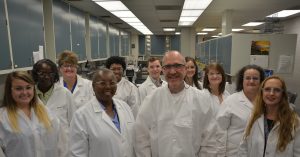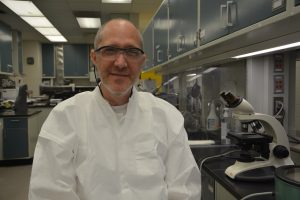Southern Research reproductive toxicology scientist Paul Bushdid, Ph.D., is working to develop a new, cost-efficient laboratory test to evaluate hazards to unborn children posed by potential medicines, chemicals and other agents.
Bushdid’s in vitro toxicology model, based on a chicken embryo, promises to deliver significant benefits. For one thing, the model should produce more rapid hazard assessments of potential threats to a developing fetus. In addition, the model could help trim the costs of drug development projects, he said.
“This in vitro model should give us the ability to assess a lot more compounds and agents at a reduced cost, with reduced animal use, and we should be able to do it faster,” said Bushdid, who is director of the Drug Development division’s Toxicology & Pathology Services and discipline leader for the Developmental & Reproductive Toxicology (DART) program.

Southern Research’s DART program performs complex preclinical studies to ensure that drug candidates, nutritional supplements, food additives and chemicals don’t endanger unborn children and pregnant women. It also examines whether these substances are negatively affecting fertility in men and women.
Bushdid said in vitro models are gaining momentum in toxicology, which provides scientific analysis of potentially hazardous chemicals and investigates the toxic properties of new substances being used in consumer products and industrial settings.
“If there are ways other than animal studies to get results – in vitro models of toxicity being one of them – we should pursue them,” he said.
CREATING A ‘POWERFUL SCREEN’
Bushdid’s project, funded internally at Southern Research, aims to significantly update and improve an older laboratory technique that was widely used in reproductive toxicology tests until the 1980s. That’s when concerns emerged about whether the chicken embryo model was the best platform for assessing teratogens, or agents that cause malformations in an embryo.
“It fell out of favor because the chicken doesn’t have a placenta, but the data shows that if you are looking at a direct teratogenic assault on an embryo, that chicken embryo model is a great model, with a high degree of predictability of what happens in humans,” Bushdid said.
To improve the in vitro model, Bushdid plans to add other assessments that have not been standard for the assay but have proved useful in animal models. Combining the two will make “a very powerful screen for assessments,” he said.
“With the chicken embryo, we can look at a very wide range of developmental stages, and we can identify potential target organs. It’s important to know if the agent in question is perfectly safe or has the potential to be lethal or cause limb defects like thalidomide did,” Bushdid said.
“That will help provide guidance on what type of further testing is needed to ensure safety for people.”

Bushdid believes the in vitro toxicology model could help hold down costs in drug discovery and development programs, which face significant financial hurdles in getting a medicine to market.
“Drug development is extremely expensive, and the cost of that eventually gets relayed to the public,” he said. “How can we help with that? Well, we can work to develop and validate alternate models for safety assessment to help reduce the overall cost of drug development.”
IMPORTANT PROTECTION
Southern Research’s DART program is a key partner of the National Toxicology Program, which is responsible for evaluating the toxic and carcinogenic potential of environmental agents that may pose a health hazard to U.S. citizens.
The NTP is affiliated with the National Institute of Environmental Health Sciences (NIEHS), which awarded Southern Research a 10-year contract to evaluate the long-term effects of early-life exposure to certain chemicals. The NIEHS is part of the National Institutes of Health.
“It’s been my personal goal in life to protect kids, before they’re born or after they’re born,” Bushdid said. “To me, children are sacred in a world that is full of dangers. The whole purpose of everything we’re doing is to make sure they are protected.”